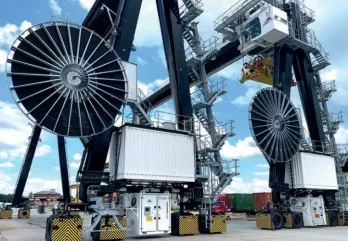
Kuenz and ABB have achieved a historic milestone by winning the largest yard crane order in European history.
Möller Maersk, and the two parties signed a major order consisting of 62 Automated Rail Mounted Gantry Cranes (ARMGs) and one Rail Mounted Gantry Crane (RGC) for the expansion project at the APM Terminals Maasvlakte II (APMT MVII) terminal in Rotterdam.
The Kuenz and ABB success story at APMT MVII terminal began in 2012 with the construction of the current facility of the project, which included 54 ARMGs for the yard and two RGCs for the fully integrated intermodal yard.
APMT MVII selected Kuenz and ABB due to the convincing overall concept of the cranes and the lowest operating costs.
In addition to the long service life of key components such as ropes and wheels, the automation and control solutions also boast the lowest maintenance hours per ARMG in the container industry.
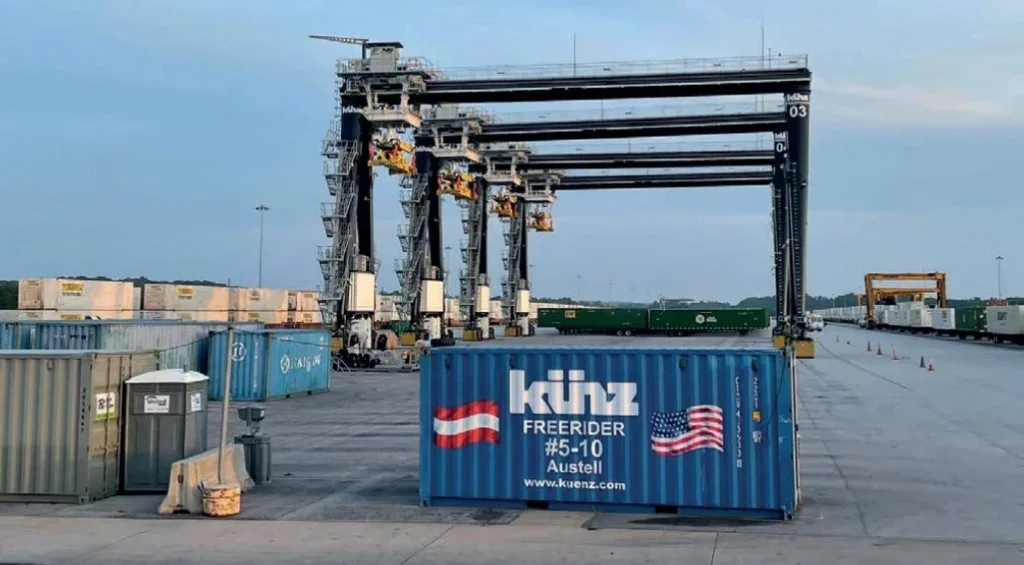
“The Kuenz ARMG Concept 2.0, introduced in the current facility of APMT MVII, was characterized by innovative new features, especially in the hoist unit. This groundbreaking development not only increased the performance of the cranes, but also significantly reduced operating costs. The positive effects of this pioneering innovation have been fully realized,” said David Moosbrugger, MD, Kuenz.
In addition to the fully automated handling of containers in the stack and in the AGV transfer zone, the automation concept in the first phase also includes the fully automated loading and unloading of trucks.
Using ABB’s technology, a range of different international chassis are identified and then precisely loaded with containers.
“In collaboration with Kuenz and APMT MVII we have been able to deliver the highest level of automation resulting in a terminal with high productivity and low maintenance needs. We are excited to take this proven concept to the next level, delivering the efficiency gains that are only available to the leaders of terminal automation,” added Clara Holmgren, business line manager Ports, ABB Marine & Ports.

Lifting speeds of up to 84 meters/minute and crane travel speeds of up to 270 meters/minute, combined with the latest automation and sensor developments from ABB, guarantee maximum handling performance.
The RGC crane, which is mechanically a copy of the existing cranes, will also be highly automated including remote operation.
“This is an important step in the expansion for APMT MVII. Kuenz and ABB once again proved to be the best solutions for the handling of our containers. The combination between the reliable automatic handling provided by ABB and Kuenz’s aerodynamic cranes makes this a sustainable choice. This allows us to not only become the most modern gateway to Europe but also the most efficient and sustainable. We look forward to a successful cooperation,” Ssaid Hans Jongejan, project director, MVII-Expansion.
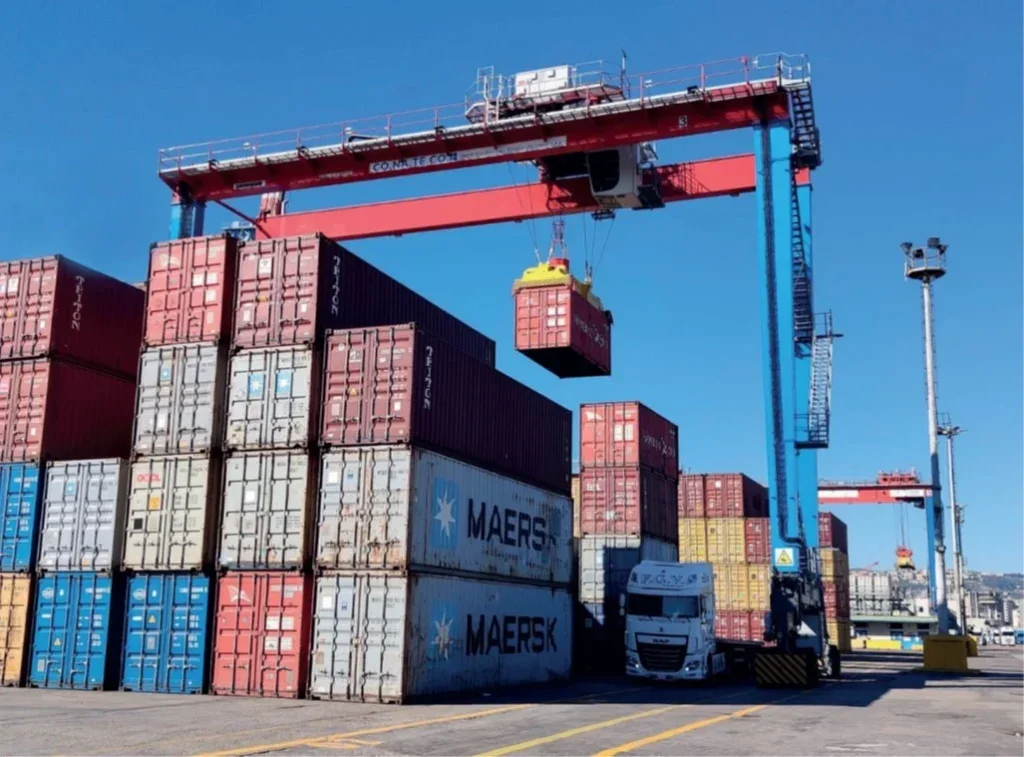
Kuenz is characterized by the traditional advantages of the aerodynamic single girder crane – not only by the lowest power consumption, but also by being the lightest crane that still offers full performance at operating wind speeds of up to 90 km/h.
The first cranes are scheduled for delivery in 2025. By mid-2027, a total of 116 stacking cranes and three rail cranes will be in operation at APMT MVII, making one of Europe’s largest container terminals even more efficient.
LIEBHERR
Liebherr Container Cranes has handed over four electric Rubber Tyre Gantry cranes (ERTG) to customers in Italy.
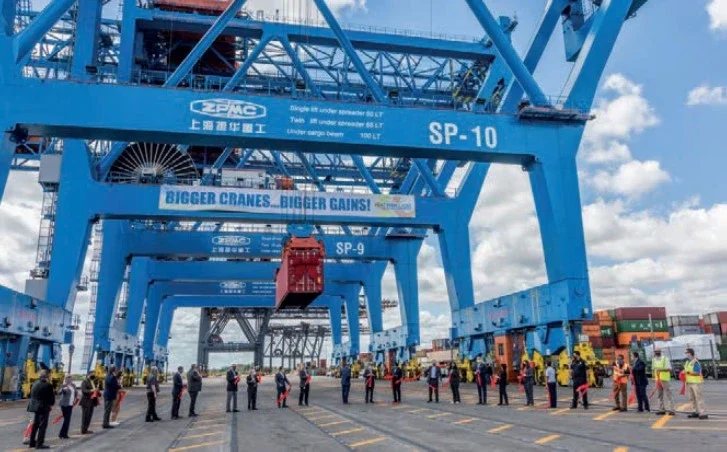
One ERTG has been delivered to Salerno Container Terminal (SCT), controlled by Gallozzi Group, while three have been delivered to Consorzio Napoletano Terminal Containers, Naples (Conateco), an MSC company. The cranes were handed over in recent weeks and will make a valuable contribution to the economies of Southern Italy and beyond.
The ERTG delivered to SCT will work container stacks 10 wide and 6 high. It is amongst the largest RTGs delivered by Liebherr. Like the three ERTGS delivered to Naples, the machines have a hybrid powertrain, operating on both diesel and electricity via cable reeling drum. This offers emission free container handling when connected to the grid and delivering substantial energy savings through onboard power regeneration.
Sustainability is a cornerstone of both projects. Salerno Container Terminal, Conateco and Liebherr Container Cranes all have sustainability in their operations, thanks to their sustainability and CSR policies and commitments.
All three companies are supporters of the United Nations Global Compact on Human Rights, sharing a common dedication to acting responsibly and collaborating with others in seeking solutions to address the global challenges of today and those that will shape the future of global businesses. Together, they are committed to fostering resilient and sustainable supply chains and accelerating the transition to a net-zero future.
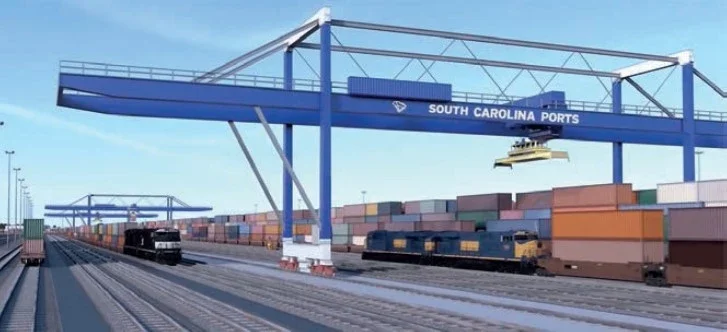
Macport plays a key role in the sales and service of Liebherr maritime cranes in Italy, Bulgaria, and Albania.
The ERTG for SCT is the latest Liebherr machine to be delivered to the terminal and joins four Liebherr Harbour Mobile cranes in container handling configuration and six Liebherr reachstackers already at the port.
Conateco is beginning its journey with Liebherr and the new Liebherr RTGs will streamline operations, improve cargo handling capacity, and contribute to the economic growth locally.
UNITED STATES
Port Everglades has partnered with ZPMC to commission three cranes in the Southport area at Florida International Terminal. The cranes are 175ft high and will increase the size of the vessels it can serve.
“The Super Post-Panamax cranes can reach farther and handle a heavier load, particularly moving containers stacked eight high from a ship’s deck and can reach 22 containers across the ship’s deck, compared to the port’s seven Post-Panamax cranes that are 151-feet (46 meters) high and limited to containers stacked six high and reaching across 16 containers. Port Everglades now has a total of 13 container gantry cranes (six are Super Post-Panamax and seven are Post Panamax) and one mobile harbour crane,” the port said.

The port has given the total structural height of the cranes (175ft), which is 53.3m. Highlighting the difficulty for low-profile cranes as the height of container stacks on deck increases, STS cranes are now being ordered today with a lift height of up to 56m, which would clear the entire structure of the these low-profile cranes.
With their design Liftech and Transhoist were able to achieve a lift height under the spreader for Everglades of 40.53m.
“With the commissioning of the new cranes, our historic $471 million project for the Southport Turning Notch Extension is nearly complete,” said Glenn Wiltshire, acting director, Port Everglades.
“However, we’re not here to just celebrate crane. We applaud the investment that our Board of County Commissioners made throughout the years to build up the port’s infrastructure, which benefits the men and women who work these docks and the regional economy.”
Finally, South Carolina Ports is investing in its rail capabilities to further support growth in the Southeast.
More than a year after groundbreaking, construction is well underway at the Navy Base Intermodal Facility.
The near-dock, rail-served cargo yard will help speed goods to market and enhance port capacity and service when it opens in July 2025.
Norfolk Southern and CSX will both serve the intermodal yard, creating a direct connection between SC Ports’ port terminals in Charleston and rail-served inland ports in Greer and Dillon, as well as to markets in the Southeast and Midwest.
The facility will have 78,000 linear feet of railroad track. Six rail-mounted gantry cranes will move containers on and off CSX and Norfolk Southern trains. A onemile dedicated drayage road will be used to truck cargo to and from Leatherman Terminal, and a future barge will transport containers between the Leatherman and Wando Welch terminals.
With a 1 million lift capacity and the ability to handle more than 14,000-foot trains, the new rail-served cargo yard will efficiently move goods between the Port of Charleston and inland markets, greatly enhancing supply chain fluidity and reliability on the U.S. East Coast.
These critical infrastructure projects are made possible by $550 million in state funding.
“We are so grateful for our state’s support to ensure we have the capacity and capabilities needed for our customers,” said Barbara Melvin, CEO/president, SC Ports. “Our state’s investment will help port-dependent businesses be successful, which will create jobs in communities around the state.”
SC Ports is also investing to expand Inland Port Greer to enable it to handle longer trains and 50% more cargo. SC Ports’ rail-served inland ports continue to perform incredibly well month after month. Inland Ports Greer and Dillon handled a combined 19,232 containers in November, a 48% increase from last year.
Container volumes were tempered in November, with empty exports driving the year-over-year decline. SC Ports handled 201,314 TEUs and 111,025 pier containers, down nearly 6% year-over-year.
SC Ports had a very strong November for vehicles, with 21,821 vehicles rolling across its docks last month. Vehicles are up 16% fiscal-year-to-date.
“As an operating port, we provide high productivity, great service and flexible solutions for our customers in the growing Southeast market,” added Melvin.
More recently, with support from the state and unanimous approval from the SC Ports Board of Directors, SC Ports plans to purchase the former WestRock paper mill site in North Charleston to further expand port capacity at the Port of Charleston.
“The tremendous backing from our state and an excellent partnership with WestRock allows us to make investments today that will support our state’s economy and create opportunities for future generations of South Carolinians,” said Melvin. “We are adding significant port capacity to support growth in South Carolina and throughout the Southeast.”
The approximately 280-acre industrial waterfront property sits adjacent to North Charleston Terminal, offering a natural extension of the container terminal that will enable SC Ports to handle more cargo for port-dependent businesses.
The additional land will expand the terminal’s capacity to handle 5 million containers in the future and create 5,000 feet of linear berth space for container ships and around 400 acres of terminal space for cargo.
“South Carolina’s economy is prospering, and we must continue to invest in our world-class port system to support the companies investing in our state,” added Melvin. “This is an incredible opportunity to enhance our high-performing North Charleston Terminal with renewed capacity to handle future growth.”
SC Ports plans to modernize the existing North Charleston Terminal with an optimized layout, upgraded cargo-handling equipment and significant new container capacity. Customers will also benefit from the on-terminal rail service offered by Palmetto Railways with dual connectivity to CSX and Norfolk Southern, and proximity to Interstate 526.
The South Carolina Department of Transportation is playing a pivotal role in the project. As part of its expansion of Interstate 526, SCDOT plans to replace the Don Holt Bridge, which will remove height constraints for larger vessels.
Plans are also moving forward to achieve a 52-foot depth up to North Charleston Terminal. The U.S. Army Corps of Engineers, Charleston District, has requested a feasibility study — a critical first step toward deepening this stretch of the Cooper River an additional five feet.
This deepening effort, combined with the new bridge height, will allow the biggest container ships calling the Port of Charleston to seamlessly access North Charleston Terminal.
“Modernizing the terminal, raising the Don Holt Bridge, deepening the Cooper River and purchasing the former WestRock property are all critical components that will yield a state-of-the-art North Charleston Terminal,” Melvin said. “These achievements would not be possible without the support and foresight from Governor Henry McMaster, SC House Speaker Murrell Smith, SC Senate President Thomas Alexander and the entire SC Legislature.”
The site also provides key support functions for Ingevity Corporation’s North Charleston manufacturing facility. SC Ports has been working closely with Ingevity to align their future needs during the transition.
SC Ports will work with SCDOT, Palmetto Railways, Ingevity and the City of North Charleston to master plan the infrastructure to best support the region’s economy and residents.
“This land purchase represents a tremendous opportunity to position our port system and our state competitively for decades to come,” Bill Stern, chairman, SC Ports Board. “Our port infrastructure investments directly support thousands of South Carolina companies that depend on SC Ports to do business, and we are expanding to ensure we have the capacity to handle the growth in the Southeast.”


